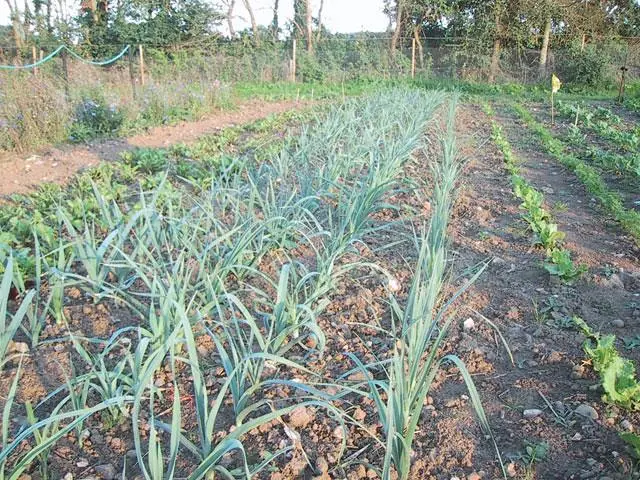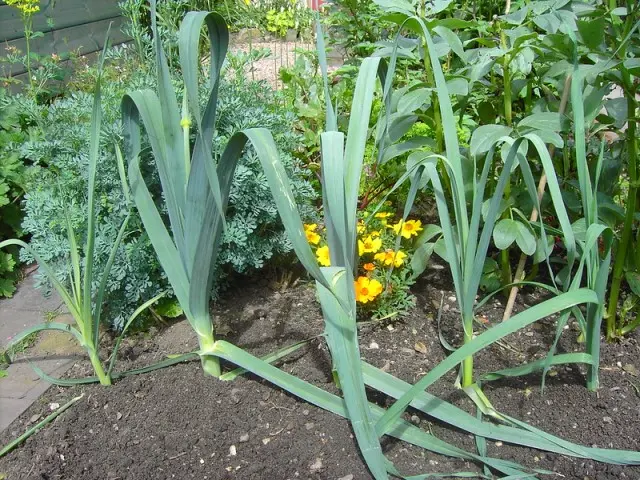Companion planting is defined as a process that offers function in the garden scheme. Companion plants for leeks repel the pests and help in each other’s growing process. It also prevents the predator insect population while improving the growing conditions. But the strong leek scent is not perfect for every plant, but some of them make the best companion for the leek plant.
Only some gardeners believe in the companion planting power, but they do not know that the companion plants thrive with some specific crops when planted near to one another. It supports crop health in most cases. Leeks are the targeted plants of many pests. Leek moth, onion maggots, or allium leaf miners are some of the most common insects that target the leek family.
Another purpose of a companion plant for leeks is that it serves as a natural insecticide. Leeks do not need any support and also act as adequate support for other plants. However, their odor assists the other plants with pest problems. Leeks can be an outstanding addition to the garden and grow perfectly and upright, add height and texture to the garden, and are visually stunning. Leeks taste amazing as a vegetable, and growing them is also simple. Leeks are from the same family of garlic and onion.
Best fruit and vegetable companion plants for the leeks

There are numerous fruits and vegetables that you can plant along with leeks. Below, we have listed some of those.
- Carrots
Carrots are the first choice for companion plants for leeks. Both leeks and carrots include fly pests that spread numerous diseases and cause damage. Carrots help to repel the leek moth and onion flies, while leek repels carrot rust flies. Carrots also enhance the leeks’ flavor. You can plant carrots in between the leek plant rows if you do not want to alternate between leeks and carrots.
- Parsnips
Leeks also repel carrot flies preying on parsnips. The parsnips break up the heavy soil and aerate it to grow leaks better. Like beets, parsnips also include a longer tap root to bring the water and the nutrients up from the deep soil where other plants, like leeks, can access it. You can alternate parsnips and leeks or plant parsnips in between the leek rows.
- Sweet peppers, tomato plants, and chili peppers
As mentioned above, leeks help in deterring the pests like ants and aphids from the vegetables like tomatoes and sweet and chili peppers. Since leeks take up small space for growing in a garden, you can interplant them near the tomato and pepper plants to fill the gaps evenly. However, some pepper plants can become massive while growing. Thus, make sure there is enough space between the pepper plants and leeks to get adequate sunlight they require for expanding.
- Melons
Leeks prevent pests with their strong odor. You can plant them like a border around the melon plants to repel the harmful insects. Never put leek plants in the melon plant patch as it will grow over and smother them.
- Beets
Beets include longer taproot going 36 to 48 inches deep into the ground. Beets extract nutrients and water from the deep underground, and the leek plants can use the additional nutrients and water that are planted near the beet plants. Beets also break up the soil so that leeks can easily grow near them. The care preferences for both beets and leeks are similar and can be grown side by side. Due to this, leeks can deter the pests from attacking the beet greens. Also, interplanting leek vegetables in between beet root-crops can help you to use most of your tiny garden space.
- Celery
You can grow both celery and leeks within a trench as both of them require the same soil and nutrients like potassium. It makes it easier to grow both plants near one another. Leeks keep away aphids, leaf miners, and carrot root flies from the celery.
- Strawberries
Strawberries and leeks are ideal friends that can grow together. Leeks keep all the pests away from strawberries, and strawberries act like an anchor to hold the soil moisture and prevent weed growth.
- Lettuce
Other green leafy vegetables like lettuce benefit from the strong, pungent odor of leek by repelling the pests. If you can plant leek to the west of the lettuce, it can get its shade in the hot season. The loose leaf of the lettuce acts like a living mulch near the leeks.
- Apple Trees
If you include fruit trees in your garden or want to plant some, consider creating a guild around it. A guild for a fruit tree is a permaculture method of tree planting by combining it with other plants. The plants and the trees will grow together collectively to create a tiny ecosystem. For apple trees, leeks are the best companion plants for creating a guild. Plant the leeks around the base of the apple tree to prevent fungi and apple scabs from harming the tree.
- Brassicas
Brassicas like cabbage, broccoli, kohlrabi, cauliflower, Brussels sprouts, and kale are the best companions for leeks. They need a similar soil structure for growing, and leek repels the cabbage worms and aphids to protect the brassicas. You can also combine beets, brassicas, and leeks and grow them. Plants always compete at different root levels for nutrients or water and enjoy a similar environment for their growth.
- Onion
You can combine other allium plants like green onions, shallots, onions, and garlic with leeks. They get along with each other very well as they share similar growing surroundings. But always plant onions or other alliums near the leeks sparingly. The plants can expand together fine, but this monoculture can cause several environmental challenges. Allium family members share similar diseases and pests, and if one plant catches them, the pests can spread swiftly among the entire plantation. It will be challenging to treat and stop those pests.
Best aromatic herbs as companion plants for leeks
Interplanting herbs with leeks in the vegetable garden is the perfect idea. Herbs are enticing the pollinators like butterflies and bees to the garden. These herbs also attract insects like lacewings, parasitic wasps, and ladybugs, helping with harmful pests.
- Thyme and Rosemary
Thyme and rosemary help to improve the leeks’ flavor, encourage insects beneficial to the leeks, and consume the pests that eat them. Thyme attracts pollinator insects benefitting the entire garden. Some thyme variety creeps along the ground and creates good mulch for the leeks.
- Chamomile
Chamomile is a flower with several benefits for the garden and is an outstanding neighbor for planting near leeks. It attracts pollinators with its anti-fungal, anti-bacterial, and sweet scent for protecting the leeks. Chamomile also improves the taste of the allium members, like shallots, garlic, onions, and leeks.
Best flowers as companion plants for leeks

Everybody loves a pop of different colors in their gardens. Different flowers act like companion plants for leeks.
- Nasturtiums
Nasturtiums repel insecticide pests like cucumber beetles and squash bugs. They are the trap crop for aphids and flea beetles. The flowers draw in advantageous insects like parasitic wasps and ladybugs that consume all the insect pests. Nasturtiums spread all across the ground and serve as outstanding living mulch. It also suppresses the weed growth and prevents the moisture from evaporating during the daytime.
- Marigolds
Marigolds are also a marvelous companion plant for leeks. The strongly scented flower can attract helpful insects like hoverflies, ladybugs, and parasitic wasps, feasting on the aphid infestations. The strong aroma of this flower acts as the best pest control for common pests in the garden, like tomato hornworms and squash bugs. Marigolds are also one of the favorite foods for spider mites, Japanese beetles, and slugs, making them an outstanding trap crop for the garden.
You can also turn the marigold flowers into the ground at the season’s end to eliminate pests like root-knotting nematodes. These flowers also offer living mulch to keep the soil moist and cool. Ensure to use Mexican and French Marigolds if you want to prevent the nematodes. If you can densely plant the marigolds surrounding the vegetables like beans, you can also prevent weed growth around them.
Toxic diseases can spread rapidly throughout the entire garden and destroy the entire setup if you put together the same type of plant in a bigger grouping. Putting different species together throughout the garden can assist in breaking up the garden and slowing the disease’s spread.
How far do we put the leeks and other companion plants apart from each other?
The rule to plant the companion plant apart from the leeks is 12 inches. This much space will give each plant sufficient room for expansion with no resource competition.
Conclusion
We have listed most of the best options for companion plants for leeks above. There are several advantages to companion planting with leeks. Through careful planning and selection, you can create a diverse and thriving ecosystem supporting abundant harvests and healthy growth. However, successful companion planting with leeks needs careful consideration and planning of the requirements of each plant.
MORE POSTS: How to grow leeks from store bought leeks?
